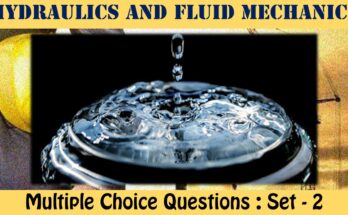MCQ Questions Mechanical Engineering Mechanics
The interviewer is almost as nervous as the candidate in most interviews. You might wonder if you look confident enough, if you will hire the right person, or if you are asking the right engineering interview questions. The last question is arguably the most crucial part to worry about when you’re interviewing candidates.
MCQ Questions Mechanical Engineering Mechanics - Set - 4
Question 1:
Center of percussion is
(a) the point of C.G.
(b) the point of metacentre
(c) the point of application of the resultant of all the forces tending to cause a body to rotate about a certain axis
(d) point of suspension
Correct Answer – (C)
Question 2 :
The center of gravity of a uniform lamina lies at
(a) the center of heavy portion
(b) the bottom surface
(c) the mid point of its axis
(d) all of the above
Correct Answer – (C)
Question 3 :
The product of either force of couple with the arm of the couple is called
(a) resultant couple
(b) moment of the forces
(c) resulting couple
(d) moment of the couple
Correct Answer – (D)
Question 4 :
Two coplanar couples having equal and opposite moments
(a) balance each other
(b) produce a couple and an unbalanced force
(c) are equivalent
(d) can not balance each other
Correct Answer – (D)
Question 5 :
A heavy ladder resting on floor and against a vertical wall may not be in equilibrium, if
(a) the floor is smooth, the wall is rough
(b) the floor is rough, the wall is smooth
(c) the floor and wall both are smooth surfaces
(d) the floor and wall both are rough surfaces
Correct Answer – (C)
MCQ Questions Mechanical Engineering Mechanics
Question 6:
Center of gravity of a solid cone lies on the axis at the height
(a) one-fourth of the total height above base
(b) one-third of the total height above base
(c) one-half of the total height above base
(d) three-eighth of the total height above the base
Correct Answer – (A)
Question 7:
In determining stresses in frames by methods of sections, the frame is divided into two parts by an imaginary section drawn in such a way as not to cut more than
(a) two members with unknown forces of the frame
(b) three members with unknown forces of the frame
(c) four members with unknown forces of the frame
(d) three members with known forces of the frame
Correct Answer – (B)
Question 8:
A framed structure is perfect if it contains members equal to (where n = number of joints in a frame)
(a) 2n-3
(b) n-l
(c) 2n-l
(d) n – 2
Correct Answer – (A)
Question 9:
According to Lami’s theorem
(a) three forces acting at a point will be in equilibrium
(b) three forces acting at a point can be represented by a triangle, each side being proportional to force
(c) if three forces acting upon a particle are represented in magnitude and
direction by the sides of a triangle, taken in order, they will be in equilibrium
(d) if three forces acting at a point are in equilibrium, each force is proportional to the sine of the angle between the other two
Correct Answer – (D)
Question 10:
D’ Alembert’s principle is used for
(a) reducing the problem of kinetics to equivalent statics problem
(b) determining stresses in the truss
(c) stability of floating bodies
(d) designing safe structures
Correct Answer – (A)
- NCERT Solutions Class 12 Mathematics RD Sharma Sets : Exercise 1.1
- NCERT Solutions Class 12 Mathematics RD Sharma Sets : Exercise 1.2
- NCERT Solutions Class 12 Mathematics RD Sharma Sets : Exercise 1.3
- NCERT Solutions Class 12 Mathematics RD Sharma Sets : Exercise 1.4
- NCERT Solutions Class 12 Mathematics RD Sharma Trigonometric Functions : Exercise – 5.1
- NCERT Solutions Class 12 Mathematics RD Sharma Trigonometric Functions : Exercise – 5.2
- NCERT Solutions Class 12 Mathematics RD Sharma Trigonometric Functions : Exercise – 5.3
- NCERT Solutions Class 12 Mathematics RD Sharma Quadratic Equations : Exercise – 14.1
- NCERT Solutions Class 12 Mathematics RD Sharma Quadratic Equations : Exercise – 14.2
- NCERT Solutions Class 12 Mathematics RD Sharma Linear Inequations : Exercise – 15.1
- NCERT Solutions Class 12 Mathematics RD Sharma Linear Inequations : Exercise – 15.2
- NCERT Solutions Class 12 Mathematics RD Sharma Linear Inequations : Exercise – 15.3
- NCERT Solutions Class 12 Mathematics RD Sharma Linear Inequations : Exercise – 15.4
- NCERT Solutions Class 12 Mathematics RD Sharma Linear Inequations : Exercise – 15.5
- NCERT Solutions Class 12 Mathematics RD Sharma Linear Inequations : Exercise – 15.6
Multiple Choice Questions for Competitive Exams
- Multiple Choice Questions Class 12 Chemistry The Solid State
Set -1 Set -2 Set -3 Set -4 Set -5 - MCQ Questions Class 12 Solutions With Answers
Set -1 Set -2 Set -3 Set -4 Set -5 - MCQ Questions Class 12 Electrochemistry With Answers
Set -1 Set -2 Set -3 Set -4 Set -5 - MCQ Questions Class 12 Chemical Kinetics With Answers
Set -1 Set -2 Set -3 Set -4 Set -5 - MCQ Questions Class 12 Surface Chemistry With Answers
Set -1 Set -2 Set -3 Set -4 Set -5 - MCQ Questions Class 12 General Principles and Processes of Isolation of Elements With Answers
Set -1 Set -2 Set -3 Set -4 Set -5




